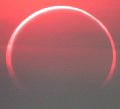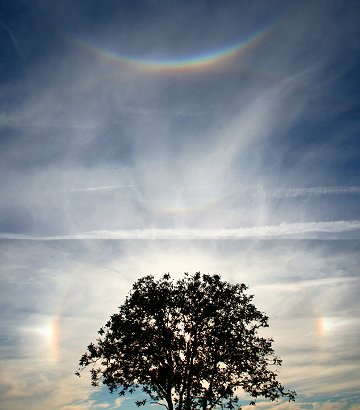 Did you miss the auroras of September? Next time get a phone alert: Sign up for SpaceWeather PHONE.
Did you miss the auroras of September? Next time get a phone alert: Sign up for SpaceWeather PHONE.
QUIET SUN: Solar activity is very low. Strong flares and auroras are unlikely this week.
SOLAR ECLIPSE: On October 3rd, the moon will glide in front of the sun, producing a solar eclipse visible from Europe, Africa and the Middle East: map. What will it look like? This depends on where you are.
 In Madrid, for instance, 90% of the sun will be covered. For four long minutes, a "ring of fire" will emerge all around the moon. Astronomers call this an annular eclipse. An example is pictured right. (Photo credit: Hans Coeckelberghs of Scotland, May 2003.)
In Madrid, for instance, 90% of the sun will be covered. For four long minutes, a "ring of fire" will emerge all around the moon. Astronomers call this an annular eclipse. An example is pictured right. (Photo credit: Hans Coeckelberghs of Scotland, May 2003.)
In Baghdad, on the other hand, only 23% of the sun is covered. The sun, viewed through a safe filter, will look like a fat crescent. Fun activity: Look for sunbeams dappling the ground through the leaves of trees. They'll look like fat crescents, too.
Millions of people can observe this event, from Madrid to Baghdad and all points in between. Get the full story from NASA.
ICE HALOES: It might be warm where you're sitting now, but 5 to 10 km above your head, the atmosphere is freezing cold. Way up there, water vapor in clouds turns to ice, and when tiny ice-crystals catch rays from the sun ... wow! A beautiful light-show materializes, such as this display photographed on Sept. 20th by Patrick Bornet of Nièvre, France:

Click to view a labeled image.
"Unbelievably well aligned ice crystals made these halos," says atmospheric optics expert Les Cowley. "Plate-like crystals set more level than our dining tables made the sundogs and the colorful circumzenithal arc. Long pencil shape crystals aligned horizontally made the tangent arc and the rare supralateral arc. Only a few crystals tumbled to produce the weak circular 22-degree halo. Why are tiny crystals so well oriented? Gentle aerodynamic drag forces act on them as they drift slowly downwards inside high cirrus clouds."

